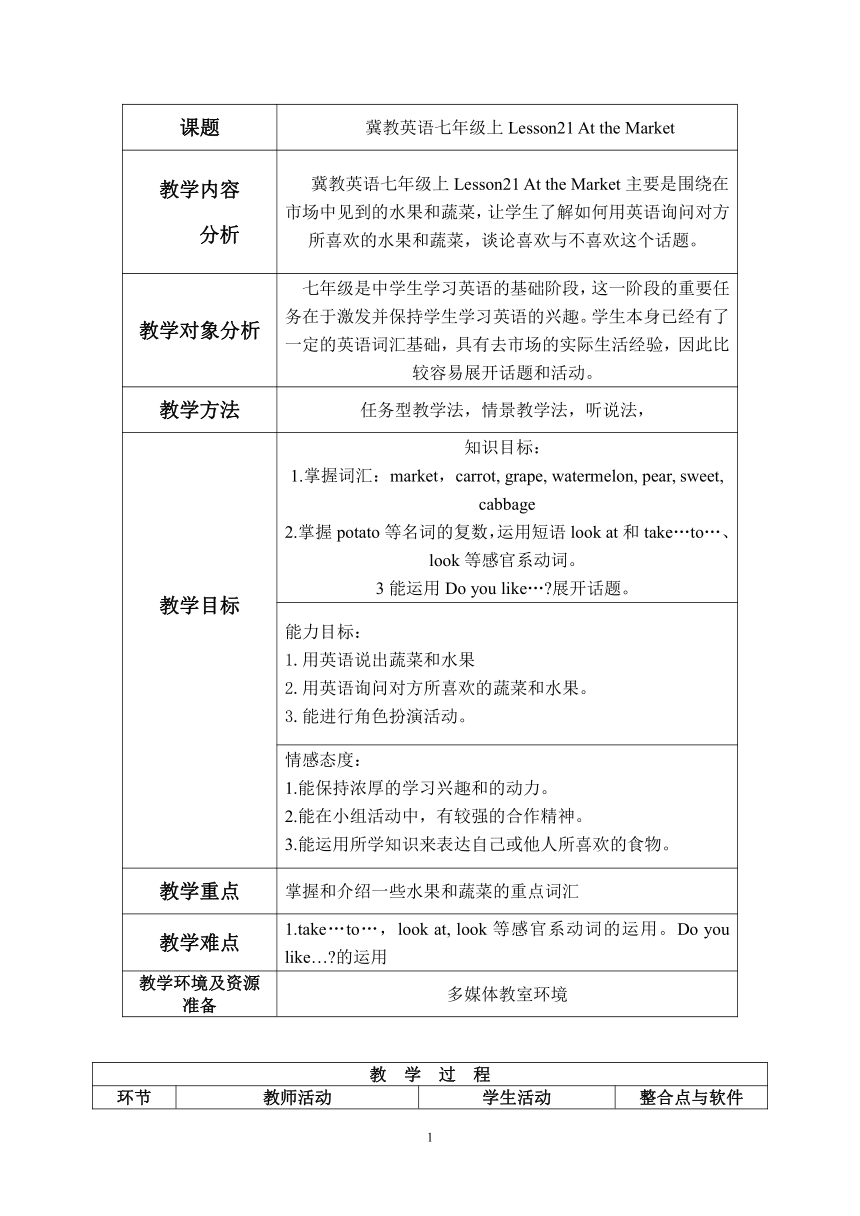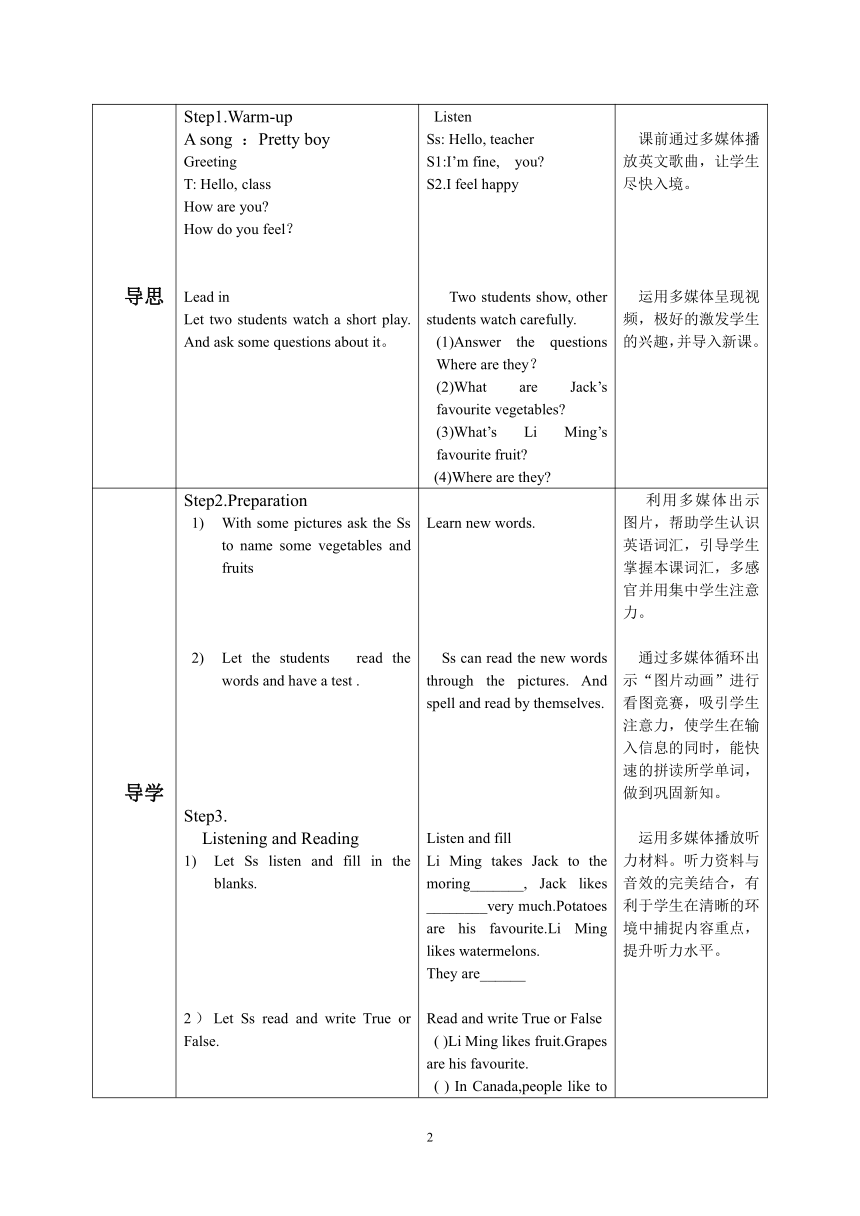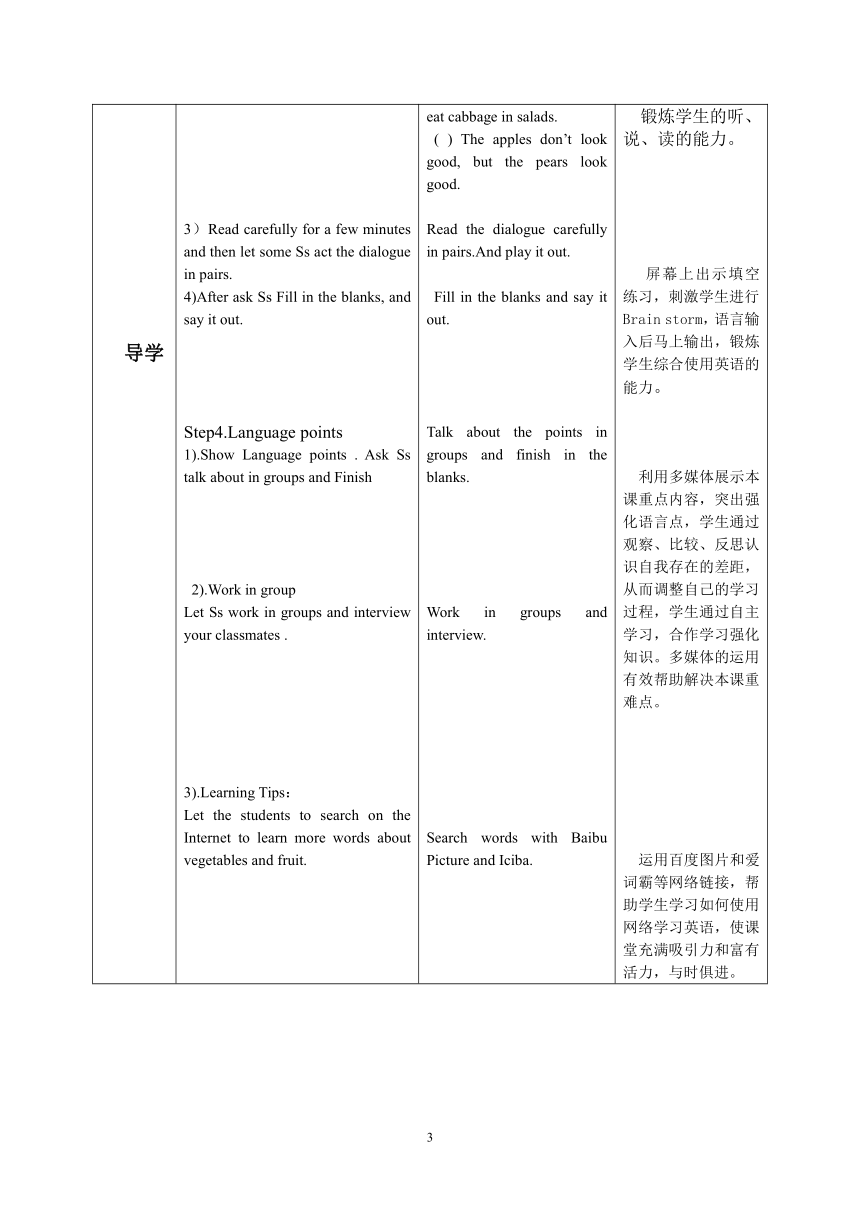冀教版七上英语Unit 4 Food and Restaurants Lesson 21 At the Market 教案
文档属性
| 名称 | 冀教版七上英语Unit 4 Food and Restaurants Lesson 21 At the Market 教案 |  | |
| 格式 | doc | ||
| 文件大小 | 85.5KB | ||
| 资源类型 | 教案 | ||
| 版本资源 | 冀教版 | ||
| 科目 | 英语 | ||
| 更新时间 | 2020-12-25 18:38:30 | ||
图片预览



文档简介
课题 冀教英语七年级上Lesson21 At the Market
教学内容 分析 冀教英语七年级上Lesson21 At the Market主要是围绕在市场中见到的水果和蔬菜,让学生了解如何用英语询问对方所喜欢的水果和蔬菜,谈论喜欢与不喜欢这个话题。
教学对象分析 七年级是中学生学习英语的基础阶段,这一阶段的重要任务在于激发并保持学生学习英语的兴趣。学生本身已经有了一定的英语词汇基础,具有去市场的实际生活经验,因此比较容易展开话题和活动。
教学方法 任务型教学法,情景教学法,听说法,
教学目标
知识目标:
1.掌握词汇:market,carrot, grape, watermelon, pear, sweet, cabbage
2.掌握potato等名词的复数,运用短语look at和take…to…、 look等感官系动词。
3能运用Do you like…?展开话题。
能力目标:
1.用英语说出蔬菜和水果
2.用英语询问对方所喜欢的蔬菜和水果。
3.能进行角色扮演活动。
情感态度:
1.能保持浓厚的学习兴趣和的动力。
2.能在小组活动中,有较强的合作精神。
3.能运用所学知识来表达自己或他人所喜欢的食物。
教学重点 掌握和介绍一些水果和蔬菜的重点词汇
教学难点 1.take…to…,look at, look等感官系动词的运用。Do you like…?的运用
教学环境及资源准备 多媒体教室环境
教 学 过 程
环节 教师活动 学生活动 整合点与软件
导思
Step1.Warm-up
A song :Pretty boy
Greeting
T: Hello, class
How are you?
How do you feel?
Lead in
Let two students watch a short play. And ask some questions about it。
Listen
Ss: Hello, teacher
S1:I’m fine, you?
S2.I feel happy
Two students show, other students watch carefully.
(1)Answer the questions Where are they?
(2)What are Jack’s favourite vegetables?
(3)What’s Li Ming’s favourite fruit?
(4)Where are they?
课前通过多媒体播放英文歌曲,让学生尽快入境。
运用多媒体呈现视频,极好的激发学生的兴趣,并导入新课。
导学
导学 Step2.Preparation
With some pictures ask the Ss to name some vegetables and fruits
Let the students read the words and have a test .
Step3.
Listening and Reading
Let Ss listen and fill in the blanks.
2)Let Ss read and write True or False.
3)Read carefully for a few minutes and then let some Ss act the dialogue in pairs.
4)After ask Ss Fill in the blanks, and say it out.
Step4.Language points
1).Show Language points . Ask Ss talk about in groups and Finish
2).Work in group
Let Ss work in groups and interview your classmates .
3).Learning Tips:
Let the students to search on the Internet to learn more words about vegetables and fruit.
Learn new words.
Ss can read the new words through the pictures. And spell and read by themselves.
Listen and fill
Li Ming takes Jack to the moring_______, Jack likes ________very much.Potatoes are his favourite.Li Ming likes watermelons.
They are______
Read and write True or False
( )Li Ming likes fruit.Grapes are his favourite.
( ) In Canada,people like to eat cabbage in salads.
( ) The apples don抰 look good, but the pears look good.
Read the dialogue carefully in pairs.And play it out.
Fill in the blanks and say it out.
Talk about the points in groups and finish in the blanks.
Work in groups and interview.
Search words with Baibu Picture and Iciba.
利用多媒体出示图片,帮助学生认识英语词汇,引导学生掌握本课词汇,多感官并用集中学生注意力。
通过多媒体循环出示“图片动画”进行看图竞赛,吸引学生注意力,使学生在输入信息的同时,能快速的拼读所学单词,做到巩固新知。
运用多媒体播放听力材料。听力资料与音效的完美结合,有利于学生在清晰的环境中捕捉内容重点,提升听力水平。
锻炼学生的听、说、读的能力。
屏幕上出示填空练习,刺激学生进行Brain storm,语言输入后马上输出,锻炼学生综合使用英语的能力。
利用多媒体展示本课重点内容,突出强化语言点,学生通过观察、比较、反思认识自我存在的差距,从而调整自己的学习过程,学生通过自主学习,合作学习强化知识。多媒体的运用有效帮助解决本课重难点。
导用
Step5.Production
1.Let the students talk about What they learn.And one stydent write down on the blackboard,the others add.
2.Do some exercises
Show some exercises
3.Some funny meanings.
Step8.Homework
Talk about the important and difficult points.
Do some exercises
1.带……去……____
2.看起来不错_____
3.在市场____ 4.……怎么样? _______
5.两个土豆 _______ 6.甜甜的西瓜_______
1. ---How many ___ would you like? ---Five.
A. bananaes B. tomatoes C. carrotes D. tomatos
2. I ___apples, but my sister likes them.
A. doesn’t like B. like C. likes D. don’t like
3. Let me __you __the morning market.
A. takes;to B. take;to C. takes;in D. take;in
4. ---What about __a watermelon? ---OK. It’s very sweet.A. buy B. to buy C. buying D. buys
5. ---Do you have ____ watermelons? ----No, I don’t. A. some B. any C. a D. much
Ask their father and mother:
What vegetables and fruit do they like?And finish the table.After that,write a short passage using the knowledge they 利用多媒体作为演示工具,在小组活动中提供话题参考,最大限度地提高每位同学的参与意识,使学生在轻松愉悦的氛围中讨论,训练听说能力。
多媒体集中呈现练习,巩固新知,学生在练习中体验成功感,感悟学英语的快乐。
多媒体呈现任务,体现话题内容,目标明确。锻炼学生的写作的能力的同时,增加对家人的了解。
板 书
设
计 Lesson21 At the Market
1.take sb/sth to …
2.potatoes, tomatoes, heroes.
3.look at sb/sth ,
4.look good: look +adj.
教 学
反
思 本课以任务型教学法为教学主线,每一个任务都是围绕学习者“学”的角度设计的;通过小组活动,培养合作探究能力;通过网络,培养学生收集信息,处理信息的能力。充分利用多媒体技术,在信息技术的支持下,改善学生的学习方式,提高教学效果。
运用多媒体技术辅助教学可以大大增加课堂容量,增大信息密度,提高教学效率,丰富学生的学习内容。利用计算机的存储和调用功能,教师可以在课堂上展示与本节课教学内容相关的各种信息,画面,声音,帮助学生掌握更多的课本以外的内容和本学科的前沿知识。
韩城镇中英语“导引学习法”课题研究导学案
年级:七年级
姓名:刘立平
课题:Lesson21 At the Market
【学习内容】:
1.掌握词汇:market,carrot, grape, watermelon, pear, sweet, cabbage
2.语法:take…to…,potato等名词的复数,look at, look等感官系动词。Do you like…?
【学习目标】
1.掌握新词汇和重点句型。
2.用英语说出蔬菜和水果。
3.用英语询问对方所喜欢的蔬菜和水果。
【学习重难点】:
1.掌握和介绍一些水果和蔬菜的重点词汇
2.take…to…,potato等名词的复数,look at, look等感官系动词。Do you like…?
【导学过程】:
一 导思:
Step1.Warm-upand Lead in
二 导学:
Step2.Preparation
Step3.Listening and Reading
Step4.Language points
Work in pairs(同组讨论,完成语言点)
1.Li Ming takes Jack to the moring market.
李明带杰克去早市。
【举例】(1) My parents will take me to the park tomrrow.
明天我父母将要带我去公园。
【用法】把(某人某物)带到(某地) __________
【应用】你能把这些书带到我的办公室里吗?
(1)Can you______ these books ___my office?
2.Potatoes are my favourite.土豆是我的最爱。
【举例】(1) Lei Feng and Dong Cunrui are my heroes in my heart.
雷锋和董存瑞是我心目中的英雄。
(2)My mother likes tomatoes. 我妈妈喜欢吃西红柿。
【用法】potato 的复数:_________
类似的名词: Negroes,_________,___________
【应用】(1).Potatoes and __________are vegetables.(tomato)
(2).My father and my mother are my ______(hero)
3.Look at the carrots. =Have a look at the carrots. 看一看这些胡萝卜。
【举例】(1)Look at the man, He is a teacher.
=Have a look at the man,He is a teacher.
看那个人,他是一名教师。
【用法】Look at 意为:________, 后接____或____
同义词为_________________.
【应用】.(1).________!The boy in red is Danny.
(2).Let me __________your photos. A.see B.Look C.Look at
4.The pears don’t look good, but the apples look good. 那些梨看上去不太好,但苹果看上去不错。
【举例】 (1)The music sounds beautiful. 这首音乐听起来很美。
(2)The cake tastes delicious。蛋糕尝起来很美味。
【用法】look,感官系动词,后接________, 意为_______。
其用法相同的词还有smell,feel,sound ,taste等感官系动词。
【应用】1.我们看起来不一样。We are_________ ________.
2.汤闻起来是美味的。The soup _________ ___________.
三 导用:
Step5.Work in group
Do you like…?
Jim
Carrots
Pears
Grapes
Watermelons
Step6. Summary
___________________________________________________________
___________________________________________________________
___________________________________________________________
Step7.Do some exercises
四 盘点收获
Ask your father and mother:
What vegetables and fruit do they like?
3
教学内容 分析 冀教英语七年级上Lesson21 At the Market主要是围绕在市场中见到的水果和蔬菜,让学生了解如何用英语询问对方所喜欢的水果和蔬菜,谈论喜欢与不喜欢这个话题。
教学对象分析 七年级是中学生学习英语的基础阶段,这一阶段的重要任务在于激发并保持学生学习英语的兴趣。学生本身已经有了一定的英语词汇基础,具有去市场的实际生活经验,因此比较容易展开话题和活动。
教学方法 任务型教学法,情景教学法,听说法,
教学目标
知识目标:
1.掌握词汇:market,carrot, grape, watermelon, pear, sweet, cabbage
2.掌握potato等名词的复数,运用短语look at和take…to…、 look等感官系动词。
3能运用Do you like…?展开话题。
能力目标:
1.用英语说出蔬菜和水果
2.用英语询问对方所喜欢的蔬菜和水果。
3.能进行角色扮演活动。
情感态度:
1.能保持浓厚的学习兴趣和的动力。
2.能在小组活动中,有较强的合作精神。
3.能运用所学知识来表达自己或他人所喜欢的食物。
教学重点 掌握和介绍一些水果和蔬菜的重点词汇
教学难点 1.take…to…,look at, look等感官系动词的运用。Do you like…?的运用
教学环境及资源准备 多媒体教室环境
教 学 过 程
环节 教师活动 学生活动 整合点与软件
导思
Step1.Warm-up
A song :Pretty boy
Greeting
T: Hello, class
How are you?
How do you feel?
Lead in
Let two students watch a short play. And ask some questions about it。
Listen
Ss: Hello, teacher
S1:I’m fine, you?
S2.I feel happy
Two students show, other students watch carefully.
(1)Answer the questions Where are they?
(2)What are Jack’s favourite vegetables?
(3)What’s Li Ming’s favourite fruit?
(4)Where are they?
课前通过多媒体播放英文歌曲,让学生尽快入境。
运用多媒体呈现视频,极好的激发学生的兴趣,并导入新课。
导学
导学 Step2.Preparation
With some pictures ask the Ss to name some vegetables and fruits
Let the students read the words and have a test .
Step3.
Listening and Reading
Let Ss listen and fill in the blanks.
2)Let Ss read and write True or False.
3)Read carefully for a few minutes and then let some Ss act the dialogue in pairs.
4)After ask Ss Fill in the blanks, and say it out.
Step4.Language points
1).Show Language points . Ask Ss talk about in groups and Finish
2).Work in group
Let Ss work in groups and interview your classmates .
3).Learning Tips:
Let the students to search on the Internet to learn more words about vegetables and fruit.
Learn new words.
Ss can read the new words through the pictures. And spell and read by themselves.
Listen and fill
Li Ming takes Jack to the moring_______, Jack likes ________very much.Potatoes are his favourite.Li Ming likes watermelons.
They are______
Read and write True or False
( )Li Ming likes fruit.Grapes are his favourite.
( ) In Canada,people like to eat cabbage in salads.
( ) The apples don抰 look good, but the pears look good.
Read the dialogue carefully in pairs.And play it out.
Fill in the blanks and say it out.
Talk about the points in groups and finish in the blanks.
Work in groups and interview.
Search words with Baibu Picture and Iciba.
利用多媒体出示图片,帮助学生认识英语词汇,引导学生掌握本课词汇,多感官并用集中学生注意力。
通过多媒体循环出示“图片动画”进行看图竞赛,吸引学生注意力,使学生在输入信息的同时,能快速的拼读所学单词,做到巩固新知。
运用多媒体播放听力材料。听力资料与音效的完美结合,有利于学生在清晰的环境中捕捉内容重点,提升听力水平。
锻炼学生的听、说、读的能力。
屏幕上出示填空练习,刺激学生进行Brain storm,语言输入后马上输出,锻炼学生综合使用英语的能力。
利用多媒体展示本课重点内容,突出强化语言点,学生通过观察、比较、反思认识自我存在的差距,从而调整自己的学习过程,学生通过自主学习,合作学习强化知识。多媒体的运用有效帮助解决本课重难点。
导用
Step5.Production
1.Let the students talk about What they learn.And one stydent write down on the blackboard,the others add.
2.Do some exercises
Show some exercises
3.Some funny meanings.
Step8.Homework
Talk about the important and difficult points.
Do some exercises
1.带……去……____
2.看起来不错_____
3.在市场____ 4.……怎么样? _______
5.两个土豆 _______ 6.甜甜的西瓜_______
1. ---How many ___ would you like? ---Five.
A. bananaes B. tomatoes C. carrotes D. tomatos
2. I ___apples, but my sister likes them.
A. doesn’t like B. like C. likes D. don’t like
3. Let me __you __the morning market.
A. takes;to B. take;to C. takes;in D. take;in
4. ---What about __a watermelon? ---OK. It’s very sweet.A. buy B. to buy C. buying D. buys
5. ---Do you have ____ watermelons? ----No, I don’t. A. some B. any C. a D. much
Ask their father and mother:
What vegetables and fruit do they like?And finish the table.After that,write a short passage using the knowledge they 利用多媒体作为演示工具,在小组活动中提供话题参考,最大限度地提高每位同学的参与意识,使学生在轻松愉悦的氛围中讨论,训练听说能力。
多媒体集中呈现练习,巩固新知,学生在练习中体验成功感,感悟学英语的快乐。
多媒体呈现任务,体现话题内容,目标明确。锻炼学生的写作的能力的同时,增加对家人的了解。
板 书
设
计 Lesson21 At the Market
1.take sb/sth to …
2.potatoes, tomatoes, heroes.
3.look at sb/sth ,
4.look good: look +adj.
教 学
反
思 本课以任务型教学法为教学主线,每一个任务都是围绕学习者“学”的角度设计的;通过小组活动,培养合作探究能力;通过网络,培养学生收集信息,处理信息的能力。充分利用多媒体技术,在信息技术的支持下,改善学生的学习方式,提高教学效果。
运用多媒体技术辅助教学可以大大增加课堂容量,增大信息密度,提高教学效率,丰富学生的学习内容。利用计算机的存储和调用功能,教师可以在课堂上展示与本节课教学内容相关的各种信息,画面,声音,帮助学生掌握更多的课本以外的内容和本学科的前沿知识。
韩城镇中英语“导引学习法”课题研究导学案
年级:七年级
姓名:刘立平
课题:Lesson21 At the Market
【学习内容】:
1.掌握词汇:market,carrot, grape, watermelon, pear, sweet, cabbage
2.语法:take…to…,potato等名词的复数,look at, look等感官系动词。Do you like…?
【学习目标】
1.掌握新词汇和重点句型。
2.用英语说出蔬菜和水果。
3.用英语询问对方所喜欢的蔬菜和水果。
【学习重难点】:
1.掌握和介绍一些水果和蔬菜的重点词汇
2.take…to…,potato等名词的复数,look at, look等感官系动词。Do you like…?
【导学过程】:
一 导思:
Step1.Warm-upand Lead in
二 导学:
Step2.Preparation
Step3.Listening and Reading
Step4.Language points
Work in pairs(同组讨论,完成语言点)
1.Li Ming takes Jack to the moring market.
李明带杰克去早市。
【举例】(1) My parents will take me to the park tomrrow.
明天我父母将要带我去公园。
【用法】把(某人某物)带到(某地) __________
【应用】你能把这些书带到我的办公室里吗?
(1)Can you______ these books ___my office?
2.Potatoes are my favourite.土豆是我的最爱。
【举例】(1) Lei Feng and Dong Cunrui are my heroes in my heart.
雷锋和董存瑞是我心目中的英雄。
(2)My mother likes tomatoes. 我妈妈喜欢吃西红柿。
【用法】potato 的复数:_________
类似的名词: Negroes,_________,___________
【应用】(1).Potatoes and __________are vegetables.(tomato)
(2).My father and my mother are my ______(hero)
3.Look at the carrots. =Have a look at the carrots. 看一看这些胡萝卜。
【举例】(1)Look at the man, He is a teacher.
=Have a look at the man,He is a teacher.
看那个人,他是一名教师。
【用法】Look at 意为:________, 后接____或____
同义词为_________________.
【应用】.(1).________!The boy in red is Danny.
(2).Let me __________your photos. A.see B.Look C.Look at
4.The pears don’t look good, but the apples look good. 那些梨看上去不太好,但苹果看上去不错。
【举例】 (1)The music sounds beautiful. 这首音乐听起来很美。
(2)The cake tastes delicious。蛋糕尝起来很美味。
【用法】look,感官系动词,后接________, 意为_______。
其用法相同的词还有smell,feel,sound ,taste等感官系动词。
【应用】1.我们看起来不一样。We are_________ ________.
2.汤闻起来是美味的。The soup _________ ___________.
三 导用:
Step5.Work in group
Do you like…?
Jim
Carrots
Pears
Grapes
Watermelons
Step6. Summary
___________________________________________________________
___________________________________________________________
___________________________________________________________
Step7.Do some exercises
四 盘点收获
Ask your father and mother:
What vegetables and fruit do they like?
3
同课章节目录
- Unit 1 School and friends
- Lesson 1 Hello!
- Lesson 2 Teacher and Students
- Lesson 3 Welcome to Our School
- Lesson 4 What Is It?
- Lesson 5 May I Have a Book?
- Lesson 6 Things for School
- Unit 2 Colours and Clothes
- Lesson 7 Jenny's New Skirt
- Lesson 8 Danny's Favourit Colou
- Lesson 9 Whose Coat Is This?
- Lesson 10 Clothes for a Cold Day
- Lesson 11 Clothes around the World
- Lesson 12 Let's Go Shopping!
- Unit 3 Body Parts and Feelings
- Lesson 13 Body Parts
- Lesson 14 Colours and Feelings
- Lesson 15 Tall or Short
- Lesson 16 Happy or Sad
- Lesson 17 Seeing a Docto
- Lesson 18 We All Look Different!
- Unit 4 Food and Restaurants
- Lesson 19 Time for Breakfast!
- Lesson 20 I Like the Supermarket!
- Lesson 21 At the Market
- Lesson 22 In the Restaurant
- Lesson 23 The Corner Store
- Lesson 24 Eat Good Food!
- Unit 5 Family and Home
- Lesson 25 Jenny's Family
- Lesson 26 Li Ming's Family
- Lesson 27 Danny at Home
- Lesson 28 A Family Picnic
- Lesson 29 A Birthday Card
- Lesson 30 Grandma's Birthday Party
- Unit 6 Let's Go!
- Lesson 31 Let's Go to the Bookstore!
- Lesson 32 At the Supermarket
- Lesson 33 Let's Go to the Zoo!
- Lesson 34 On the Farm
- Lesson 35 Let's Go to the Museum!
- Lesson 36 Let's Go to the Movie Theatre!
- Unit 7 Days and Months
- Lesson 37 Seasons and Weathe
- Lesson 38 Nick's Busy Month
- Lesson 39 A Class Calenda
- Lesson 40 When Is Your Birthday?
- Lesson 41 Holidays
- Lesson 42 Happy Holidays!
- Unit 8 Countries around the world
- Lesson 43 Directions
- Lesson 44 Jack's Goodbye Party
- Lesson 45 China
- Lesson 46 Canada and the U.S.
- Lesson 47 The U.K. and Australia
- Lesson 48 English-Speaking Countries
